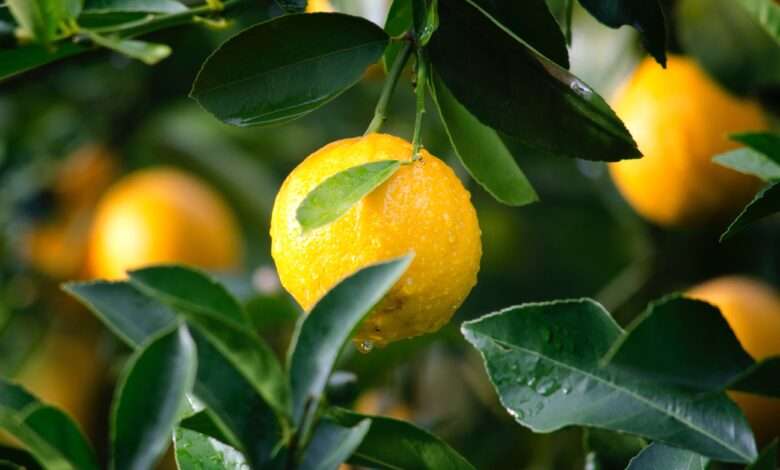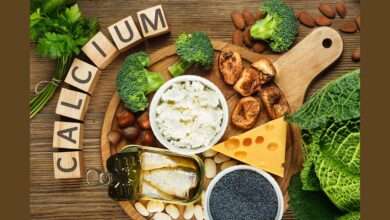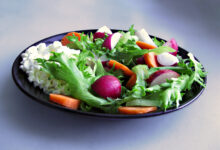
How to choose the right lemon?
Lemon is a citrus fruit from the lemon tree, a shrub native to Asia and cultivated since the Middle Ages. A ripe lemon weighs on average between 150 to 200g and has a thick dark yellow skin, even slightly orange for some varieties.
lemon id card
- Family: Rutaceae;
- Origin: Asia;
- Season: February to September;
- Yellow color ;
- Flavor: very acidic.
Choosing the right lemon
The skin of the juiciest lemons and limes is thin and shiny, never lumpy. Fruit should be firm and heavy in the hand.
The leaves of kaffir lime (the lime tree of the Citrus hystrix species) can be found fresh, dried or frozen in oriental grocery stores. Dried leaves quickly lose their aroma and are of less culinary interest than fresh and frozen leaves. Sometimes we also find the fruit of kaffir lime, a bumpy-skinned lime.
Preserving lemon
- Fresh lemons will keep for 1 or 2 weeks at room temperature, limes for less time, as they dry out more quickly. By keeping lemons and limes in a container of water in the refrigerator or simply in a tightly closed container, they will keep longer;
- If you have large quantities of these fruits, you can squeeze them and freeze the juice in an ice cube tray;
- Candied limes and lemons . Split the limes or lemons into four lengthwise, keeping them attached at one end, fill them with coarse salt (about 125 ml – ½ cup for 4 lemons), put them in a mason jar in packing them well and cover with lemon (or lime) juice. Leave to macerate for about 1 week, then put in the refrigerator. The candied fruits will easily keep there for 6 months, even longer;
- Dehydrated bark . Dried at room temperature, they keep for a very long time in a spice jar. They will lose some of their flavor as they dry, but will still add flavor to a dish. The white part being more bitter, one can dry only the zest, which one will take with a vegetable peeler or a zester.
How to prepare lemon
The tart taste of lemon and lime stimulates the taste buds, which is great for digestion. They are rich in vitamin C and contain various compounds that would prevent cancer.
Using Lemon Juice in Cooking
Citrus fruits are juiciest when they are at room temperature. Therefore, it is best to take them out of the refrigerator some time before consuming them. To extract as much juice as possible, roll the fruit with your hand on a work surface before juicing it. Then all you have to do is integrate it:
- In ice creams, sorbets, granitas;
- In creams, pies and cakes;
- In vinaigrette, replacing vinegar;
- In lemonade, in tea, hot or iced, or in infusions;
- As a fillet on fish and seafood;
- On raw oysters, to enhance their taste in addition to destroying the majority of bacteria that could be found there;
- To deglaze a pan;
- To make homemade sour cream, add a little lemon juice to fresh cream, let set and drain;
- In Mexico, beer is drunk seasoned with a squeeze of lemon or lime juice;
- Butter of hotel supervisor. Cream the butter, add salt, pepper, minced parsley then, still beating, add a few drops of lemon juice. Coat a grilled meat with this sauce;
- Lime juice works better in Mexican salsa than lemon. Try the salsa cruda by mixing equal parts sweet onion, cilantro leaves and chopped tomatillos. Add a minced jalapeno pepper and the juice of one or two limes, depending on the quantity of vegetables;
- In Japan, lemon juice, soy sauce, dashi and spring onions are mixed to prepare the Ponzu sauce that accompanies grilled meat dishes;
- Prepare the fish in ceviche, Peruvian style, by simply macerating it in lemon or lime. The acidic juice has the effect of “cooking” the fish, which can be eaten without further preparation.
Cook the lemon zest
Try the zest (the outer layer of the rind) of lime or lemon in mashed potatoes, rice or pasta. Gremolata is an Italian aromatic mixture made up of equal parts orange and lemon zest, finely chopped garlic and parsley. It is added, when serving, on an osso-buco, a leg of veal or any other braised meat.In Japan, the lemon peel is cut into thin strips and added at the very end to salads, on vegetables or grilled tofu, in scrambled eggs or soup.
Lemon pulp, an ally in the kitchen
Lemon and lime pulp is rarely eaten because it is very acidic. With the exception, however, of candied lemons, essential in North African cuisine. One of the classics of this cuisine is the chicken with olives and candied lemons, cooked as a tagine. You can also serve the pulp and zest with rice, fish or lamb.
Lemon contraindications and allergies
Although excellent for general health, lemon is very acidic, which does not allow it to be tolerated by everyone. Especially when consumed pure and/or in too large quantities. Caution should therefore be exercised in certain situations.
Caution in case of antacid treatment
One should avoid consuming lemon or lime, or their juices, along with antacid medications. Indeed, several citrus fruits increase the absorption of aluminum contained in antacids. It is better to space out the intake of antacids and citrine fruits or their juice by 3 hours.
Moderate consumption in case of GERD and heartburn
Lemon, lime, as well as their juices, should also be avoided by people suffering from gastroesophageal reflux disease, peptic esophagitis and hiatal hernia (in the acute phase of these diseases). These foods can cause irritation to the lining of the esophagus or cause heartburn.
History and anecdotes
The lemon was first called “limon”, a term borrowed from the Italian limone, which itself came from the Arabic-Persian limûn. The word appeared in the French language in 1351. From this comes the word “limonade” which, unlike “limon”, still exists today. The term “lemon”, born in 1398, is derived from the Latin citrus. It gradually replaced “limon” in popular language.
A little history
The first reference to lemon is in Chinese writings. A first mention dates from 1175, while a detailed description appears in a work published in 1178. These mentions, as well as certain other elements noted by historians, indicate that the lemon was probably introduced into China between the tenth century and the middle of the twelfth century. There is no archaeological evidence to determine its origin with certainty, but researchers believe they can say that it comes from the eastern Himalayan region in southern China, more precisely from Upper Burma.
The lemon was perhaps cultivated by the Greeks and Romans, or even by the Egyptians, but there are hardly any traces of this cultivation, except on mosaics of the time. It could also be the citron (Citrus medica), its probable ancestor, known for a long time, both in the East and in the West, for its medicinal properties. Over the course of invasions and climatic fluctuations, the lemon may have disappeared from southern Europe on a few occasions to be reintroduced there later. After the barbarian invasions (350 to 400 AD), it was the Arabs who took over the reins of trade. They will spread the lemon, introducing it to North Africa, Africa and Spain, as well as throughout the Mediterranean basin, with the exception of the Italian and French coasts.
Finally, during the Crusades in the Middle East, Western, Eastern and Northern Europeans discovered citrus fruits and developed a taste for these acidic and juicy fruits which they brought back to their respective countries. From there will be born the first greenhouses, called orangeries, in which first orange and lemon trees will be grown, then all kinds of tropical plants.








